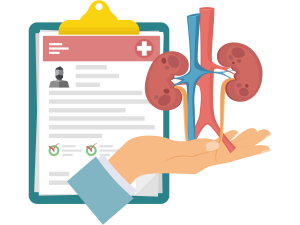Topic: Cytomegalovirus in Transplant Patients
H&P: A 60-year-old male who received a lung transplant six months ago for advanced COPD presents with fever, chills, fatigue, leukopenia, shortness of breath, and a productive cough. Patient has also been experiencing nausea and vomiting, and not able to tolerate food for over a week.
PMH: BMI: 17.4, HTN, COPD, Lung transplant
Medications: Metoprolol, Prednisone, Tacrolimus, and Cyclosporine
Labs: WBCs:3.5 > 3.7 > 3.8; HBG: 8.1 > 8.5 > 8.8; Platelets:122 > 116 > 128; ABGs:pH 7.30; pCO2: 55; pO2: 51; SaO2: 86%
Vitals: HR 88-92, BP’s 174/82; 164/92; 150/78, RR: 28-32, Temp: 39.0-39.4, Sp02: 92 % on 6L HFNC, Chronically on 2L O2 NC at night.
CXR: Bilateral lower lobe infiltrates with interstitial changes; Likely Viral Pneumonia.
Attending Progress Notes: Patient six months post lung transplant presents with SOB, increased oxygen need, on transplant rejection medications. Chest x-ray demonstrates probable Viral Pneumonia. Start Relenza. Nausea and vomiting resolved. Will obtain a sputum culture for definitive diagnosis. Wean O2 from 6LNC per respiratory therapy. Continue supplemental ensure until patient tolerating over 80% of meals.
Sputum Culture Result: Positive for Cytomegalovirus
Discharge Summary: Viral pneumonia in post-lung transplant patient, HTN, leukopenia and thrombocytopenia likely due to immune suppressant medications.

Question: Are there query opportunities based on the scenario stated above?
Discussion: The patient exhibited the following risk factors and clinical indicators:
- ABGs: pH 7.30; pCO2: 55; pO2: 51; SaO2: 86%
- Sp02: 92 % on 6L HFNC
- BMI: 17.4
- WBCs:3.5 > 3.7 > 3.8; HBG:8.1 > 8.5 > 8.8; Platelets:122 > 116 > 128
- CXR: Bilateral lower lobe infiltrates with interstitial changes
- Sputum Culture Result: Positive for Cytomegalovirus
- Six Months Post Lung Transplant
UASI Recommends:
- Query for Acute Hypoxic Respiratory Failure (J96.01)
- Query for Immunodeficiency due to drugs (D84.821)
- Query for Pancytopenia due to drugs (D61.811)
- Query for Cytomegalovirus (B25.9)
- Query for Underweight (R63.6, Z68.1)
Documentation without Clarification:
- Principal Diagnosis: Lung transplant infection (T86.812)
- Secondary Diagnosis: Other Viral Pneumonia (J12.89), HTN (I10), Leukopenia (D72.819), Thrombocytopenia (D69.6)
- Working DRG: 205 Other Respiratory System Diagnoses with MCC
- RW: 1.6848 GMLOS: 4.1 SOI/ROM: 3/2
Documentation with Clarification:
- Principal Diagnosis: Lung transplant infection (T86.812)
- Secondary Diagnosis: Cytomegaloviral Pneumonitis (B25.0), HTN (I10), Acute Hypoxic Respiratory Failure (J96.01), Immunodeficiency due to drugs (D84.821), Other drug induced pancytopenia (D61.811), Underweight (R63.6), BMI 19.9 or less, adult (Z68.1)
- Working DRG: 205 Other Respiratory System Diagnoses with MCC
- RW: 1.6848 GMLOS: 4.1 SOI/ROM: 4/3
CDI Educational Tips:
Cytomegalovirus (CMV) is a virus in the herpes family. CMV infections are very common. In the United States, over half of adults have been exposed to CMV at some point in their lives, often during childhood or early adulthood. After initial infection, the virus remains in the body for the rest of your life. Most of the time, the virus stays dormant (inactive). However, it can become active again (reactivated) in certain situations such as stress or an immune system problem.
CMV can affect almost any organ and cause almost any type of infection. Anti-rejection drugs taken after surgery help prevent a rejection episode, but they also inhibit part of the immune system. Since the body’s ability to fight infection is decreased, transplant recipients are more prone to viruses and infections.
Cytomegalovirus (CMV) is a common and major cause of opportunistic infection in organ transplant recipients, causing significant morbidity and mortality. CMV is most often caused by a reactivation of CMV acquired long before your transplant. If you develop your first CMV infection, the virus likely came from your transplanted organ. (The donor might have been exposed to the virus.) The risk of CMV disease is highest amongst organ recipients who are CMV seronegative prior to transplantation and receive allografts from CMV-seropositive donors (i.e., CMV D+/R- mismatch).
If present, some symptoms include:
- Fever with temperature greater than 100.4 degrees Fahrenheit or 38 degrees Celsius
- Low white blood cell counts (leukopenia)
- Muscle weakness
- Fatigue
- Shortness of breath
- Blurry vision or loss of vision
CMV is difficult to diagnose, since its symptoms mimic many other illnesses. CMV might be detected through blood tests that indicate the presence of the CMV virus. Urine and sputum cultures also might detect the virus. Biopsy of the infected organ can also indicate the presence of the CMV virus.
Patients diagnosed with CMV are treated with antiviral medicine delivered intravenously or by mouth.
Query Tip: Query for the confirmation of Cytomegalovirus (CMV) type. Ensure that the diagnosis of CMV meets the definition for other diagnosis.
Reference: https://medlineplus.gov/lab-tests/cytomegalovirus-cmv-tests/
This is a short synopsis of a possible patient record and is not intended to be all inclusive. This is for educational purposes only and not intended to replace your institutional guidelines.
To view last month’s CDI scenario, click here.